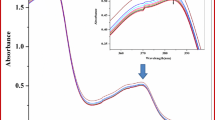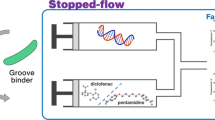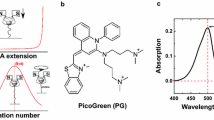Abstract
We have observed a number of discrepancies and contradictions in the use of a fluorescent intercalator displacement assay in surveying the binding affinities of dinuclear polypyridyl ruthenium(II) complexes with DNA. By a modification of the assay using the fluorescent minor-groove binder 4′,6-diamidino-2-phenylindole, rather than intercalating dyes (ethidium bromide or thiazole orange), results were obtained for all complexes studied which were consistent with relative affinities and stereoselectivities observed with other techniques, including NMR, affinity chromatography and equilibrium dialysis. It is believed that the difference in binding mode between the minor groove-binding Ru(II) complexes and the intercalating fluorescent dyes they are displacing may contribute to these discrepancies.







Similar content being viewed by others
References
Quivy V, Calomme C, Dekoninck A, Demonte D, Bex F, Lamsoul I, Vanhulle C, Burny A, Lint CV, (2004) Cloning Stem Cells 6:140–149
Geierstanger BH, Wemmer DE (1995) Annu Rev Biophys Biomol Struct 24:463–493
Patterson BP, Collins JG, Foley FM, Keene FR (2002) J Chem Soc Dalton Trans 4343–4350
Smith JA, Collins JG, Patterson BT, Keene FR (2004) Dalton Trans 1277–1283
Morgan JL, Buck DP, Turley AG, Collins JG, Keene FR (2005) Inorg Chim Acta 359:888–898
Morgan JL, Buck DP, Turley AG, Collins JG, Keene FR (2006) J Biol Inorg Chem 11:824–834
Smith JA, Morgan JL, Turley AG, Collins JG, Keene FR (2006) Dalton Trans 3179–3187
Taylor JS, Schultz PG, Dervan PB (1984) Tetrahedron 40:457–465
Trauger JW, Dervan PB (2001) Methods Enzymol 340:450–466
Lukin M, Santos C (2006) Chem Rev 106:607–686
Lee J, Guelev V, Sorey S, Hoffman DW, Iverson BL (2004) J Am Chem Soc 126:14036–14042
Wheate NJ, Evison BJ, Herlt AJ, Phillips DR, Collins JG (2003) Dalton Trans 3486–3492
Boger DL, Fink BE, Brunette SR, Tse WC, Hedrick MP (2001) J Am Chem Soc 123:5878–5891
Boger DL, Tse WC (2001) Bioorg Med Chem 9:2511–2518
Lewis MA, Long EC (2006) Bioorg Med Chem 14:3481–3490
Goodwin KD, Lewis MA, Tanious FA, Tidwell RR, Wilson WD, Georgiadis MM, Long EC (2006) J Am Chem Soc 128:7846–7854
Smith JA, Keene FR (2006) Chem Commun 2583–2585
Kapuscinski J (1995) Biotech Histochem 70:220–233
Wilson WD, Tanious FA, Barton HJ, Jones RL, Fox K, Wydra RL, Strekowski L (1990) Biochemistry 29:8452–8461
Yun BH, Kim JH, Lee BW, Lincoln P, Norden B, Kim J, Kim SK (2003) J Phys Chem 107:9858–9864
Youn MR, Moon SJ, Lee BW, Lee D, Kim J, Kim SK, Lee C (2005) Bull Korean Chem Soc 26:537–542
Lee BW, Moon SJ, Youn MR, Kim JH, Jang GH, Kim SK (2003) Biophys J 85:3865–3871
Westerlund F, Wilhelmsson LM, Nordén B, Lincoln P (2005) J Phys Chem B 109:21140–21144
Acknowledgement
We gratefully acknowledge the financial support of the Australian Research Council.
Author information
Authors and Affiliations
Corresponding author
Electronic supplementary material
Below is the link to the electronic supplementary material.
Rights and permissions
About this article
Cite this article
Spillane, C.B., Smith, J.A., Morgan, J.L. et al. DNA affinity binding studies using a fluorescent dye displacement technique: the dichotomy of the binding site. J Biol Inorg Chem 12, 819–824 (2007). https://doi.org/10.1007/s00775-007-0235-9
Received:
Accepted:
Published:
Issue Date:
DOI: https://doi.org/10.1007/s00775-007-0235-9




